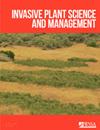Reduced hack and squirt treatment with aminocyclopyrachlor and aminopyralid for invasive shrub control
IF 1.2
4区 生物学
Q3 PLANT SCIENCES
引用次数: 0
Abstract
Abstract Invasive shrubs often present extremely difficult challenges for individual plant treatment approaches due to multiple basal stems with complex branching patterns. Basal bark and cut stump individual plant treatments have been the standard methods for managing large-statured shrubs, while hack and squirt has been disregarded as operationally too difficult. However, hack and squirt is a more discriminant treatment technique that may lead to a reduction in herbicide use. Here, we evaluated the speed, herbicide use, and performance of a reduced hack and squirt approach using single hacks per stem injected with 0.5 ml of either aminocyclopyrachlor (240 g L–1) or aminopyralid (240 g L–1) against conventional low-volume basal bark treatment with triclopyr ester (96 g L–1) and cut stump treatment with triclopyr amine (180 g L–1). The experiments were conducted on three subtropical shrub species: Eugenia uniflora, Lagerstroemia indica, and Schinus terebinthifolia. Across species, we found the reduced hack and squirt approach resulted in comparable treatment efficacy to basal bark and cut stump treatment, was faster than cut stump treatment, and used less herbicide and carrier than basal bark treatment. A single hack per stem is a significant shift for hack and squirt treatment, which typically employs a narrow or continuous spacing of hacks around the entire circumference of each stem. Future work should seek to clarify the applicability of this approach over a wide range of invasive shrubs.氨环吡咯胺和氨吡啶减砍喷施防治入侵灌木
摘要入侵灌木由于具有复杂分枝模式的多个基部茎,通常对个体植物处理方法提出极其困难的挑战。基生树皮和树桩单株处理一直是管理高大灌木的标准方法,而砍和喷则因操作难度太大而被忽视。然而,黑喷是一种更具判别性的处理技术,可能会减少除草剂的使用。在这里,我们评估了使用每根树干注射0.5毫升氨基环吡草胺(240 g L-1)或氨基吡喃草胺(240g L-1。对三种亚热带灌木进行了试验研究:独花Eugenia uniflora、紫薇Lagerstroemia indica和大叶Schinus terebinthifolia。在不同物种中,我们发现减少砍和喷方法的处理效果与基部树皮和截桩处理相当,比截桩处理更快,并且比基部树皮处理使用更少的除草剂和载体。每根茎进行一次黑客攻击是黑客和喷射治疗的一个重大转变,通常在每根茎的整个圆周上使用狭窄或连续的黑客间距。未来的工作应该寻求澄清这种方法在广泛的入侵灌木中的适用性。
本文章由计算机程序翻译,如有差异,请以英文原文为准。
求助全文
约1分钟内获得全文
求助全文
来源期刊

Invasive Plant Science and Management
PLANT SCIENCES-
CiteScore
2.20
自引率
9.10%
发文量
24
审稿时长
6-12 weeks
期刊介绍:
Invasive Plant Science and Management (IPSM) is an online peer-reviewed journal focusing on fundamental and applied research on invasive plant biology, ecology, management, and restoration of invaded non-crop areas, and on other aspects relevant to invasive species, including educational activities and policy issues. Topics include the biology and ecology of invasive plants in rangeland, prairie, pasture, wildland, forestry, riparian, wetland, aquatic, recreational, rights-of-ways, and other non-crop (parks, preserves, natural areas) settings; genetics of invasive plants; social, ecological, and economic impacts of invasive plants and their management; design, efficacy, and integration of control tools; land restoration and rehabilitation; effects of management on soil, air, water, and wildlife; education, extension, and outreach methods and resources; technology and product reports; mapping and remote sensing, inventory and monitoring; technology transfer tools; case study reports; and regulatory issues.
 求助内容:
求助内容: 应助结果提醒方式:
应助结果提醒方式:


